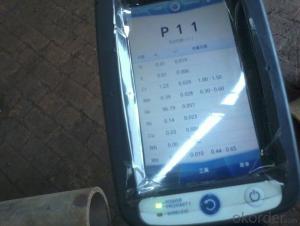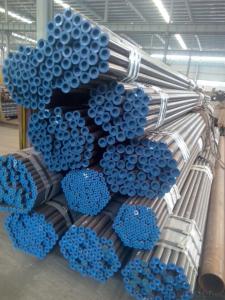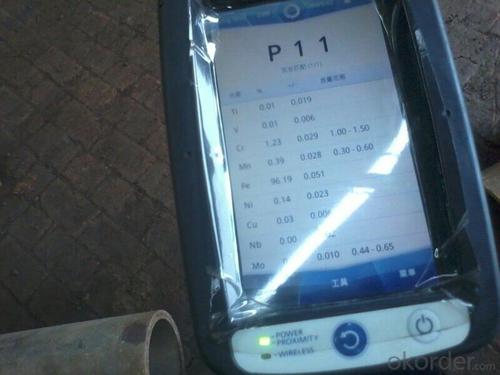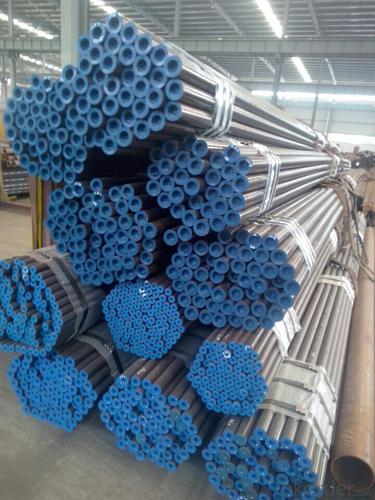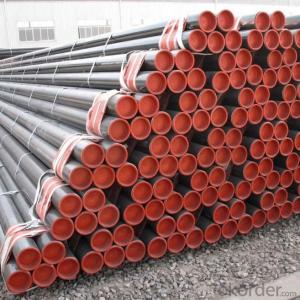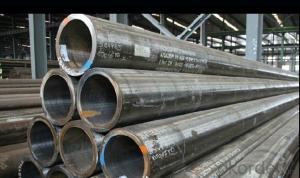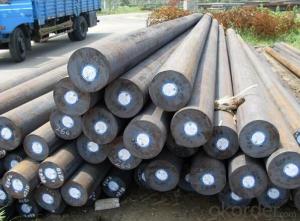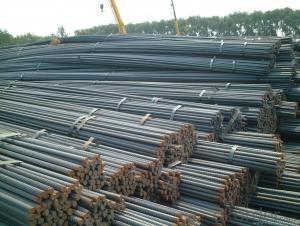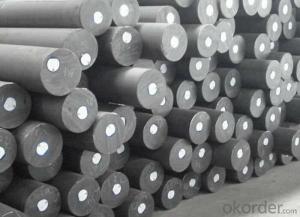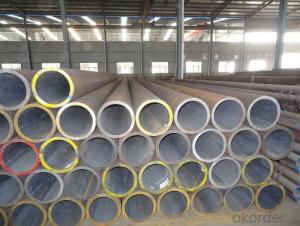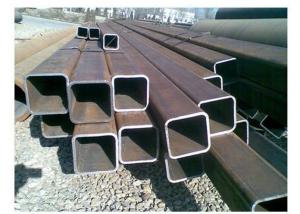A335P11 alloy tube
- Loading Port:
- Shanghai
- Payment Terms:
- TT OR LC
- Min Order Qty:
- -
- Supply Capability:
- 30000 kg/month
OKorder Service Pledge
OKorder Financial Service
You Might Also Like
P11 alloy tube can be recycled 100%, in line with the national strategy of environmental protection and energy conservation, conservation of resources, the national policy to encourage the expansion of the application fields of P11 alloy high-pressure pipe.
P11 alloy steel pipe is placed in the metal blank cold extrusion die cavity, at room temperature, through the press fixed punch pressure is applied to the blank, processing method to produce plastic deformation of P11 alloy steel pipe made of parts.
[1] extruded P11 alloy steel pipe size accurate smooth surface: at present our country in the development of P11 alloy steel pipe generally size precision can reach 8 ~ 9
Level, long degrees generally reach, if the lubrication can reach by ideal (refers to pure aluminum and copper parts), second only to the polishing surface. Therefore made of P11 alloy steel pipe method of parts, generally do not need to re processing, a small amount of just finishing (grinding).
[2] to save raw materials: P11 alloy steel material utilization rate is usually can reach more than 80%. Such as Jiefang automobile piston pin dynamic cutting material utilization rate is 43.3%, while the use of cold extrusion material utilization rate increased to 92%; and as the universal joint bearing sleeve to cold extrusion, the material utilization rate increased from 27.8% to 64% in the past. Visible, by cold extrusion method for producing machine parts, and can save a lot of steel and non-ferrous metal materials.
[3] high productivity: the efficiency of extrusion production machinery parts P11 alloy steel pipe by the method of cold is very high, especially the mass production of parts with cold extrusion steel tube production method, P11 alloy than cutting increased several times, dozens of times, even hundreds of times. For example, automobile piston pin cold extrusion method for manufacturing improved 3.2 times than by cutting, with current and piston pin cold extrusion automata, to further improve productivity. The productivity of a cold extrusion automata productivity is equivalent to 100 ordinary lathe or 10 sets of four spindle automatic lathe.
[4] can process the complex shape parts: such as profiled, inner gear, profiled hole and blind hole, the P11 alloy steel pipe is used in other processing method is difficult to finish, with cold extrusion processing is very convenient. As shown in the parts, convenient extrusion.
[5] the cold extrusion of P11 alloy steel high strength, good rigidity and light weight: because the cold extrusion adopts metal material cold deformation hardening of cold extrusion characteristics, namely the metal blank in three to the compressive stress state, the deformed materials, and has dense microstructure fiber flow continuous, so the parts strength greatly to improve the. So that it can use low strength material instead of high strength materials. For example, in the past 20Cr steel by machining manufacturing Jiefang piston pin, now changed to 20 steel by manufacturing piston pin cold extrusion, the determination of the indexes of performance, higher than the machining method of manufacturing piston pin cold extrusion of P11 alloy steel tube method.
Conclusion
Comparison of various processing methods, has outstanding advantages in cold extrusion of P11 alloy steel pipe technology and project. It is cold extrusion machining, forging, instead of casting and drawing process to produce machine parts, has opened up a broad road.
The 1 seamless steel tube
Because of the different manufacturing processes, divided into hot-rolled (extrusion) seamless steel pipe seamless steel pipe cold drawing (rolling) and two. Cold drawing (rolling) tube is divided into a circular tube shaped tube two.
Overview of A. process
Hot-rolled (extrusion seamless pipe): billet, heating, perforation, three roll cross rolling, rolling or extrusion, tube off, sizing pipe (or reducing), cooling, the blank pipe, straightening, water pressure test (or testing), marking, storage.
Cold drawing (rolling) seamless steel pipe: round tube billet, heating, perforation, heading, annealing, pickling, oiling (copper) and multi pass drawing (Leng Zha), the blank pipe, heat treatment, straightening, water pressure test (testing), marking, storage.
B. seamless steel tube, because of their different purposes is divided into the following several varieties:
GB/T8162-2008 (seamless steel tube structure). Mainly used for general structure and mechanical structure. The representative of material (grade): carbon steel 20, 45 steel; alloy steel Q345, 20Cr, 40Cr, 20CrMo, 30-35CrMo, 42CrMo etc..
GB/T8163-2008 (fluid with seamless steel pipe). Mainly used for conveying fluid pipeline engineering and large equipment. Representative of material (grade) 20, Q345.
GB3087-2008 (seamless steel tubes for low and medium pressure boiler). Mainly used for industrial boilers and boiler life conveying low pressure fluid pipeline. The representative material for 10, 20 steel.
GB5310-2008 (high pressure boiler seamless pipe). Mainly used in power stations and nuclear power plant boiler high temperature, high pressure fluid delivery set box and pipe. Representative of 20G, 12Cr1MoVG, 15CrMoG etc..
GB5312-1999 (carbon steel and carbon manganese steel seamless steel tube for ship). Mainly used for ship boiler and Superheater I, II grade pressure pipe, etc.. The representative material for 360, 410, 460 grade steel etc..
GB6479-2000 (seamless steel tubes for high-pressure chemical fertilizer equipment). Mainly used for conveying fluid of high temperature and high pressure pipeline of chemical fertilizer equipment. Representative of the material is 20, 16Mn, 12CrMo, 12Cr2Mo etc..
GB9948-2006 (seamless steel tubes for petroleum cracking). Mainly used for boiler, oil refinery heat exchanger and pipes conveying fluid. The representative material for 20, 12CrMo, 1Cr5Mo, 1Cr19Ni11Nb etc..
GB18248-2000 (seamless steel tubes for gas cylinders). Mainly used for the production of gas, hydraulic cylinders. The representative of 37Mn, 34Mn2V, 35CrMo etc..
GB/T17396-1998 (hot rolled seamless steel tubes for hydraulic prop). Mainly used in production of coal mine hydraulic support cylinder, column, and other hydraulic cylinder, column. The representative material for 20, 45, 27SiMn.
GB3093-1986 (high pressure seamless steel tubes for diesel engine). Mainly used for diesel engine high pressure oil injection system. The steel pipe is generally drawn tube, the representative of 20A.
GB/T3639-1983 (cold drawn or cold rolled precision seamless steel tube). Mainly used for mechanical structure, carbon pressure equipment used, the requirements of high dimensional accuracy, surface finish
- Q: What are the different methods of coating steel pipes?
- There are several methods of coating steel pipes, including fusion bonded epoxy (FBE) coating, polyethylene (PE) coating, polyurethane (PU) coating, and cement mortar lining. These coatings are applied to protect the steel pipes from corrosion, increase their lifespan, and improve their performance in various applications.
- Q: What is hot rolled steel pipe? What is a cold drawn steel tube?
- Hot rolling is relative to cold rolling, cold rolling is performed under recrystallization temperature, while hot rolling is rolling above recrystallization temperature.
- Q: What does GALV mean in a steel tube?
- Steel tube (Steel pipe) production technology development began in the bicycle manufacturing industry, the rise of the early nineteenth Century during the oil development, the two world war ships, boilers, aircraft manufacturing, manufacturing of power boiler after the Second World War, the development of chemical industry of petroleum and natural gas drilling and transportation, will effectively promote the the yield and quality of varieties, the development of steel tube industry.
- Q: How are steel pipes tested for quality?
- Steel pipes are tested for quality through various methods such as visual inspection, dimensional measurement, mechanical testing, and non-destructive testing. Visual inspection ensures that there are no surface defects or deformities on the pipes. Dimensional measurement involves checking the pipe's size, thickness, and length to meet the required specifications. Mechanical testing involves subjecting the pipes to stress, pressure, and temperature to assess their strength and durability. Non-destructive testing techniques like ultrasonic, radiographic, or magnetic particle testing are used to detect any internal flaws or defects without damaging the pipes. These comprehensive quality tests ensure that steel pipes meet the necessary standards before they are used in various applications.
- Q: How many fasteners are there in a ton of steel tubes?
- The fastener generally refers to the intermediate connecting parts connecting two members, in the construction project for external diameter of steel pipe scaffold with 48mm fixation, the fastener is divided into rectangular fastener (cross directional fastener fastener) rotary fastener (universal movable fastener fastener) (a direct docking fastener fastener fastener) etc..
- Q: What is the difference between steel pipe and tubing?
- Steel pipe and tubing serve various purposes, but they possess distinct dissimilarities. The fundamental distinction between them stems from their shape and dimensions. Steel pipe, ordinarily circular in shape, features a hollow interior. It is manufactured in a range of sizes and thicknesses to accommodate diverse pressure and temperature prerequisites. Steel pipe frequently finds employment in construction, plumbing, and the oil and gas industries for the conveyance of fluids or gases. Conversely, steel tubing can adopt a variety of shapes, such as circular, square, and rectangular. Unlike steel pipe, tubing is typically evaluated by its outer diameter and wall thickness. Structural applications, such as building frames, automotive components, and machinery, often employ steel tubing. Another divergence between steel pipe and tubing lies in their manufacturing processes. Steel pipe is typically fashioned from solid steel billets, which are heated and stretched to produce a seamless or welded tube. On the other hand, tubing can be generated through diverse methods, including hot or cold rolling, welding, or extrusion. In terms of strength and durability, both steel pipe and tubing offer excellent qualities. Nevertheless, the particular requirements of the application will dictate which one is more suitable. Steel pipe is frequently selected for high-pressure or high-temperature applications, whereas steel tubing is favored for structural purposes or when a specific shape is necessary. In summary, the primary disparity between steel pipe and tubing resides in their shape, measurement techniques, and manufacturing procedures. While steel pipe possesses a round shape and is measured by its inner diameter, tubing can adopt various shapes and is usually measured by its outer diameter. Both steel pipe and tubing find extensive use in diverse industries, but the choice depends on the specific application and requirements.
- Q: What are the different grades of steel pipes?
- The different grades of steel pipes vary based on their chemical composition and physical properties. Some commonly used grades include carbon steel pipes (grades A, B, and C), alloy steel pipes (grades P1, P5, P9, and P11), stainless steel pipes (grades 304, 316, and 321), and duplex steel pipes (grades 2205 and 2507). Each grade offers specific characteristics suited for different applications and industries.
- Q: What are the different coating options for steel pipes?
- There are several different coating options available for steel pipes, including fusion bonded epoxy (FBE) coating, three-layer polyethylene (3LPE) coating, three-layer polypropylene (3LPP) coating, coal tar enamel (CTE) coating, and zinc coating. These coatings help to protect the steel pipes from corrosion and extend their lifespan.
- Q: How do you calculate the maximum allowable deflection for steel pipes?
- The maximum allowable deflection for steel pipes can be calculated using various formulas and guidelines set by industry standards. Factors such as the material properties of the steel, pipe diameter, wall thickness, and the applied load are taken into consideration. These calculations typically involve using equations that relate to the pipe's moment of inertia, modulus of elasticity, and the specific loading conditions. It is recommended to consult relevant engineering codes and standards, such as ASME B31.1 or ASME B31.3, to ensure accurate calculations and safe design.
- Q: How are steel pipes used in sewage systems?
- Steel pipes are commonly used in sewage systems due to their durability and strength. They are used to transport sewage from homes, buildings, and industries to treatment plants or disposal sites. The corrosion-resistant properties of steel make it an ideal material for sewage systems, ensuring longevity and preventing leaks. Additionally, steel pipes can withstand high pressure and heavy loads, making them suitable for underground installations.
Send your message to us
A335P11 alloy tube
- Loading Port:
- Shanghai
- Payment Terms:
- TT OR LC
- Min Order Qty:
- -
- Supply Capability:
- 30000 kg/month
OKorder Service Pledge
OKorder Financial Service
Similar products
Hot products
Hot Searches
Related keywords
